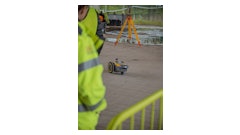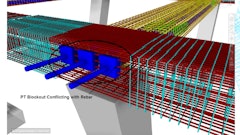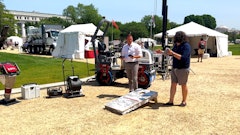
Construction technologies from equipment automation to surveying equipment rely on the global navigation satellite system (GNSS), a component of which is the NAVSTAR Global Positioning System (GPS). GNSS signals, however, have to pass through the ionosphere, the atmospheric layer 50 miles to 400 miles above the earth’s surface. In this layer, solar radiation including extreme ultraviolet and X-rays cause atoms to ionize—lose and gain electrons to create positively and negatively charged particles. The free electrons affect the way GNSS signals travel through the ionosphere. At certain times, factors including the number of sunspots and related solar flares can predictably change the way GNSS solutions perform.
For contractors, mining companies and others relying on these devices to operate, this can mean downtime costing thousands or even hundreds of thousands.
Fortunately, these disturbances follow a cyclical pattern that enable GNSS technology to compensate. However, contractors using GNSS receivers, particularly those used in equatorial environments or at high latitudes, should make sure that their devices are updated with the latest firmware, which will help mitigate these ionospheric effects.
Trimble Announces Update
This is important context to Trimble’s October 10 announcement of Trimble IonoGuard, an update designed to mitigate ionospheric disruptions in positioning and navigation by minimizing performance impacts caused by scintillation or signal noise.
The disturbances peak every 11 years with the next peak projected between 2024 and 2026. This ionospheric activity can degrade the accuracy of GNSS positioning data and is most noticeable on high-precision GNSS around equatorial countries like Ecuador, Colombia, Venezuela or Brazil—and high latitude regions, including Canada, Scandinavia and U.S. states including:
- Washington
- North Dakota
- Minnesota
- Wisconsin
- Michigan
- New York
- Vermont
- Maine
Also affected are Northern regions of the United Kingdom and some parts of New Zealand and Australia.
To remedy this, Trimble IonoGuard is part of a firmware update users will be able to download in the final quarter of 2023. This update will work for Trimble GNSS receivers under warranty that use the Trimble ProPoint GNSS positioning engine and will minimize impact of complete loss of GNSS signals and improve signal quality, accuracy and integrity.
RTK Receivers: Ionospheric Disruption Insights
This is a complex phenomenon that impacts a broad spectrum of the construction industry, so IRONPROS sat down for a briefing following the IonoGuard announcement with Trimble Portfolio Manager Ed Norse. Norse has been in the industry for a while.
“This is my fourth 11-year cycle that we've come through,” Norse said. “The problem mainly occurs in equatorial and high latitude regions, so the majority of our customers, hopefully, will not be affected at all. And people in mid-latitudes will generally not see issues. However, we don't know what size of disturbance we're going to get with the cycle. This cycle could be much bigger, and it's looking like it will be bigger than previous peaks in the solar cycle. We are concerned that it could come down into more mid-latitudes where most of our customers are in the U.S. and Europe.”
While GNSS solution vendors release updates for each cycle, the evolution of the technology itself means the degree to which customers are affected changes, independent of variations in the phenomenon itself.
“Back four cycles ago, we only had single-frequency GPS,” Norse said. “In the next cycle in the late ‘90s, we had dual-frequency GPS—and dual-frequency GPS helps us quite a bit with this problem. Now, we have four frequencies coming from the satellites that we're using. We have a lot more processing power in the receivers, a lot more channels to track all the satellites in the sky. So yes, we have released an update each time but not as significant as we have in this latest IonoGuard technology.”
The geographic concentration of customers using more sophisticated real-time kinematic (RTK) receivers may also affect which users will see a disturbance.
“We mainly see the problems today in these regions where we have high-precision RTK receivers, either in mining or agriculture and some construction. That is something we did not have 40 years ago, or even 20 years ago. Today, Trimble has more customers, so it's become more of an issue in the more recent cycles.”
Regardless of where on the globe a customer operates, Norse still recommends that they update their firmware.
“Most of our receivers shipped in the last year or so are ProPoint-enabled receivers. They will be able to upgrade to this new firmware, which includes IonoGuard," Norse said.
Trimble customers running older equipment or even competitor systems at their RTK base stations may still benefit from IonoGuard if they have it enabled on their roving ProPoint receivers.
“A lot of our receivers older than a year or two are not upgradeable to the ProPoint capability,” Norse said. “However, you can still benefit from IonoGuard technology. The optimum performance will be if you have a ProPoint receiver at your base station and a ProPoint receiver on all your roving machines. But you do also get some benefit if you only have IonoGuard running on the roving machines and not on your base. So, you could have an old base or you could have a competitor’s base, and you'll still get benefits on your IonoGuard enabled machines. For customers in an area where they're concerned (they may be seeing ionospheric activity), it is important [that] they use this new firmware to identify if they are experiencing ionospheric interference. You can run the firmware, and you can look at the data and realize this area is affected and make the decision to update the firmware on all receivers.”
Other vendors will also have updates to deal with ionospheric interference, according to Norse, but Trimble’s approach may be more nuanced.
“One of the key benefits in IonoGuard is that the base station functions as the guard,” Norse said. “So, it's looking for ionospheric interference because the base station can see the ionosphere a lot better than the rover receiver. The base station is identifying which satellites are being affected by ionospheric interference and then sending that information to the rover. Not everyone handles it that way. We think this is a superior way of doing it—being able to identify it at the base and tell the rovers which signals to be wary of.”
Vigilance Is Key
While Norse said the goal is to avoid starting a panic in the industry, come 2024 and 2025, contractors and others relying on this technology should be on guard and watching for anomalies.
“If you're in mid-latitudes, I would not panic,” Norse said. “I would just be aware of this phenomenon. If you do see your accuracy degrading, this could be one of the things on the list that you should be aware of. There are a lot of other things that could be the culprit—your base station could be in a bad location. You could have bad multipath, local interference or jamming. You could have a receiver or antenna that's got a faulty component or damaged cable. There are many things. But this is one thing that should be on your mind. And you should go check what the levels of ionospheric interference are in your location at the time. And then, if you can upgrade all receivers to the latest Trimble software, even our older receivers do have some improvement in tracking that will help you in any difficult condition. So, upgrade your firmware, and if you have a ProPoint receiver, make sure it's the one that includes IonoGuard and work with your Trimble support team or dealer to help you out if you have any issues installing that.”





























